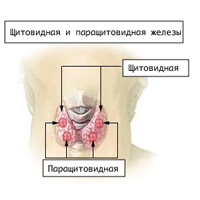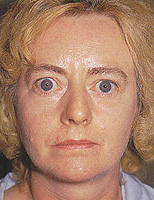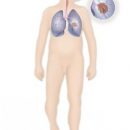Acromegalia is an unusual disease in which people become larger faces, the size of the brushes and stops increases. However, it is one of the most harmless symptoms of the disease. Read more about the manifestations of acromegaly, read in the article.
Content
Acromegaly - a disease in which the production of growth hormone (somatotropin) increases, while there is a violation of proportional growth of the skeleton and internal organs, in addition, there is a violation of metabolism.
In childhood and youthful age, giantism is developing in excessive growth, and after completion of growth, acromegaly develops.
The main role in the development of acromegaly plays an increase in the development of growth hormone. The reason for the increase in somatotropin products is adenoma (benign tumor) pituitary, which has its own activity. Slightly less often there may be damage to the hypothalamus or other brain departments (tumors, skull injuries with brain shaking, emotional and mental brain loads).
Stages of development of acromegaly
The disease develops years. During the acromegaly allocate a number of stages:
- Precircherhalia - characterized by the earliest signs, is quite rare, because the symptoms are not very pronounced. It is necessary to repeatedly explore the level of somatotropin in the blood and make computer tomography of the brain to reveal the disease.
- Hypertrophic stage - characterized by a full bouquet of disease manifestations.
- Tumor stage - At this stage, there are violations associated with the squeezing of the pituitary tumor near the positions of the brain: blood pressure is encouraged: the sensitivity of individual parts of the body appears.
- Cachectic stage - the stage of exhaustion - is the outcome of the disease.
 Acromegaly manifests as follows
Acromegaly manifests as follows
- Patients have a headache, memory deterioration, sexual weakness (in men), a disruption of the menstrual cycle (in women), reducing vision.
- Patients with acromegaly acquire a characteristic appearance: an increase in the abnormal arcs, ear shells, nose, tongue, zick bones, lips, brushes and stop (an increase mainly in width, because of which patients are forced to change the dimensions of gloves, shoes, rings); The lower jaw appears forward, the gaps between the teeth increase; The skin is thickened, with rude folds on the face; chest increased in volume.
- At the beginning of the disease, an increase in muscle strength and performance of patients is noted, but later the muscle destruction occurs, resulting in muscle weakness and soreness.
- An increase in the nutrition of the cartilage joints is developing, which leads to the appearance of acromegal arthropathy (slandering destruction).
- If the tumor is too pronounced, then the squeezing of visual nerves, located near the pituitary, may be squeezing, because of what impaired impairment.
- With the further development of the disease, signs of damage to internal organs (heart, lungs, kidneys) can develop: an increase in blood pressure, an increase in the heart, a violation of his work.
- Half people have violations of glucose exchanges, because of which sugar diabetes develops.
- If in patients tumor «Zeshette» hypothalamus, then patients may have drowsiness, thirst, increasing the amount of urine, sharp temperature lifts.
- Half patients have a diffuse or nodal goiter, which is associated with the production of the hormone pituitary tumor, affecting the work of the thyroid gland.
Ultimately evolve (cachexia). In the absence of appropriate treatment, the life expectancy of patients is 3-4 years. With slow development and a favorable course, a person can live from 10 to 30 years. If the acromegaly is treated in a timely manifestation, its manifestations are not so bright, and a person can calmly live a few dozen years.









